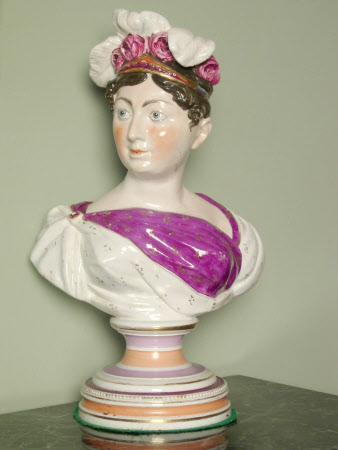Charlotte Augusta, Princess of Wales (1796-1817)
J. & R. Riley
Category
Ceramics
Date
1819
Materials
Ceramic
Measurements
400 mm (Height)
Order this imageCollection
Croft Castle, Herefordshire
NT 537392
Summary
Bust, soft paste porcelain, of Charlotte Augusta, Princess of Wales (1796-1817), by John & Richard Riley, Hill Works, Burslem, Staffordshire, 1819; finely modelled, depicting Charlotte Augusta with tiara, a headdress of roses and feathers, wearing a draped garment fastened at one shoulder; standing on a circular socle; decorated in naturalistic colours, with purple-coloured glazes to the roses and part of the garment, which is also picked out with floral gilt detailing, the socle with bands of purple, maroon, orange and gilt, with a border of moulded beading. Inscribed by hand on the back of the shoulders in overglaze red enamel, cursive script, 'J & R. Riley,/ 1819'.
Full description
Bust, soft paste porcelain, of Charlotte Augusta, Princess of Wales (1796-1817), by John & Richard Riley, Hill Works, Burslem, Staffordshire, 1819; finely modelled, depicting Charlotte Augusta with tiara, a headdress of roses and feathers, wearing a draped garment fastened at one shoulder; standing on a circular socle; decorated in naturalistic colours, with purple-coloured glazes to the roses and part of the garment, which is also picked out with floral gilt detailing, the socle with bands of purple, maroon, orange and gilt, with a border of moulded beading. Inscribed by hand on the back of the shoulders in overglaze red enamel, cursive script, 'J & R. Riley,/ 1819'. Princess Charlotte is the only portrait bust known with certainty to have been made by the Riley brother's firm, which principally produced transfer printed earthenware (Halfpenny, 1991, 206). There is only one other marked example recorded, which is in the collection of the Mint Museum, North Carolina, making Croft's bust an important and rare example (Gallagher, 2015, cat. 176, accession number 1968.29.7). The example at the Mint Museum has several variations in colour to that at Croft, notably the garment being left in the white with different gilt floral detailing and different colouring to the socle. The treatment of the face is also different, with the Croft example being more highly coloured. The source for the bust might be a print by Robert Cooper (d. 1828) published by Rudolph Ackermann on 4 June 1816, after Alfred Edward Chalan (1760-1860) (see National Portrait Gallery, NPG D33513). Another possibility is a simpler print by Miss Robert, published by Robert Miller on 26 January 1818, which shows the Princess with a similar profile, rose headdress and prominent curls at her temples (see National Portrait Gallery, NPG D8116). The death of Princess Charlotte was a cause of national mourning and many ceramic manufacturers responded by creating commemoratives. Busts of a similar large scale and with very similar modelling are known in pearlware with brightly coloured enamelled decoration, which would be a cheaper alternative to porcelain (see Beddoe, 2015, cat. 69; Temple Newsam, Leeds, LEEAG.CE.1938.10.117). Princess Charlotte had been a patron of the Chamberlain's porcelain factory in Worcester and in 1814 had awarded it a special royal warrant. About 1822, Chamberlain's produced a richly gilt vase featuring her portrait, painted by Humphrey Chamberlain Jr and presumably a special commission (Bonhams, London, 29 September 2021, lot 47). At Croft, the bust is shown alongside a bust of Prince Leopold of Saxe-Coburg-Saalfeld, which is unmarked but very possibly also by John & Richard Riley. They are shown in commemoration of the death of the princess and her child during childbirth, which was attended by Dr Richard Croft, later 6th Baronet. It has been suggested that they might have been commissioned by Croft (Berthoud, 2004, p. 8), though this is perhaps unlikely as they are companions rather than an exactly matching pair. By descent at Croft Castle; purchased by the National Trust at auction at the Croft Castle sale organised by Sotheby's, 6 June 2002, lot 235 (together with NT537393). References: Illustrated in Roger Pomfret, 'John & Richard Riley, China and Earthenware Manufacturers', Journal of Ceramic History, Vol. 13, pl. 26 (Stoke-on-Trent: City Museum & Art Gallery, 1989). Stella Beddoe, A Potted History: Henry Willett's Ceramic Chronicle of Britain (Suffolk: Antique Collectors' Club, 2015) Michael Berthoud, 'Riley, Machin and Mrs. Cleggett', The Northern Ceramic Society, Newsletter No. 136, December 2004, pp. 7-9. Brian Gallagher (ed.), British Ceramics 1675-1825 (London: The Mint Museum in association with D Giles Ltd, 2015) Anthony Oliver, Staffordshire Pottery: The Tribal Art of England (London: Heineman, 1981)
Provenance
By descent at Croft Castle; purchased by the National Trust at auction at the Croft Castle sale organised by Sotheby’s, 6 June 2002, lot 235 (together with NT 537393).
Makers and roles
J. & R. Riley, sculptor
